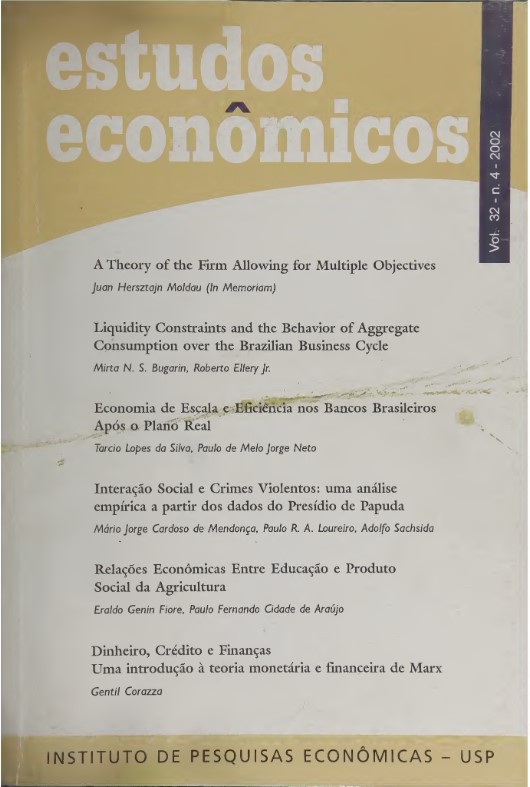Interação social e crimes violentos: uma análise empírica a partir dos dados do presídio de Papuda
Keywords:
Social interactions, Criminality, Sample selection biasAbstract
This article is based on the theoretical model developed by Becker ( 1968 ). which establishes the relationship between socialinteraction and illegal behaviour. Using data from the prison of Papuda in Distrito Federal, behaviour relations are estimated showing that the variables of social interaction as good family environment have negative effects on criminality rates. In addition, a selection bias model (HECKMAN, 1979) was used to estimate a behaviour function, the estimates ofwhich show a statistically significant difference in the modus operandi between people committing violent crime and those who not committing violent crime.
Downloads
References
BECKER, G. Crime and punishment: an economic approach. Journal of Political Economy, v. 101, p. 169-217, 1968.
BECKER, Gary S. A theory of social interactions. Journal of Political Economy, v. 82, n. 6, p. 1063-93, 1974.
BECKER, G.; TOMES, N. An equilibrium theory of the distribution of income an intergenerational mobility.Journal ofPolitical Economy, v. 87, p. 1163-1189, 1979.
BLUMSTEIN, A. Touth violence, guns and the illicit-drug industry. The Journal of Criminal Law and Criminology, v. 86, n. 4, p. 1175-1216, 1995.
BLUMSTEIN, A.; ROSENFELD, R. Explaining recent trens in U. S. homicide rates. The Journal ofCriminal Law and Criminology, v. 86, n. 1, p. 10-36, 1998.
EHRLICH, I. Participation in illegitimate activities: a theorical and empirical investigation. Journal ofPolitical Economy, v. 81, p. 521- 565, 1973.
EHRLICH, I. Deterrent effect of capital punishment: a question of life and death. American Economic Review, p. 397-417, December 1975.
FAJNZYLBER, P.; LEDERMAN, D.; LOAYZA, N. What causes violent crime. World Bank Report, 1998.
FLEISCHER, B. M. The effect of income on delinquency. American Economic Review, v. 56, p. 118-137, 1966.
FREEMAN, R. B. The economics of crime. In: ASHENFELTER, O.; CARD, D. (eds.),Handbook of labor economics. Elsevier Science, 1999, v. 3.
FREEMAN, R. B.; RODGERS El, W M. Area economic conditions and the labor market outcomes of young men in the 1990s expansion. NBER Working Paper 7073, April 1999.
GLAESER, E. L.; SACERDOTE, B.; SCHEINKMAN, J. A. Crime and social interactions. Quarterly Journal of Economics, v. Ill, p. 507-548, 1996.
GOLDBERGER, Arthur S. A course in econometrics. Cambridge, Massachusetts: Havard University Press, December 1991.
GREENE, W Econometric analysis. Prentice Hall, 1993.
GROGGER, Jeffrey. Local violence and educational attainment. The Journal of Human Resources, Madison, v. 32, Issue 4, p. 659-682, Fall 1997.
HECKMAN, J. Sample selection bias as a specification error. Econometrica, v. 47, n. 1, p. 153-161, 1979.
HECKMAN, J. The common structure ofstatistical models oftruncation, sample selection, and limited dependent variables and a simple estimator for such models. Annuals of Economic and Social Measurement, 5, p. 475-92, 1976.
IMAI, Susumu; KRISHNA, Kala. Employment, dynamic deterrence and crime. NBER Working Paper n. w8281. Disponível em: http://papers.nber.org/papers/W8281. Issued in May 2001.
JUDGE, George G.; HILL, R. Carter; GRIFFITHS, William E.;
LUTKEPOHL, Helmut; LEE, Tsoung-Chao.Introduction to the theory and practice of econometrics. John Wiley & Sons, Inc. 1982.
LEVITT, S. D. The effect ofprison population size on crime rates: evidence from prison overcrowding; litigation. Quarterly Journal of Economics, v. Ill, p. 320-351, 1996.
LEVITT, S. D.; LOCHNER, Lance. The determinants ofjuvenile crime. NBER Wirking Paper Disponível em: http://www.nber.org/books/gruber/juvenilecrime.pdf. University of Rochester, p. 1-58, February 2000.
LOCHNER, L. A theoretical and empirical study ofindividual perceptions of the criminal justice system. Working Paper n. 483, June 2001. Disponível em: http;//ideas.uqam.ca/ideas/data/Papers/rocrocher483.html University of Rochester, p. 1-53.
SAH, R. Social osmosis and patterns of crime. Journal of Political Economy, v. 99, p. 1272-1295, 1991.
STATA. Stata User^s Guide, Realease 6. College Station, Texas: Stata Press WILLIS, R.; ROSEN, S. Education and self-selecxion.Journal of Political Economy, v. 87, S1-S36, 1979.
WITTE, Ann Dryden; WITT, Robert. What we spend and what we get: public and private provision of crime prevention and criminal justice. NBER Working Paper n. w8204. Issued in April 2001. Disponível em: http://papers.nber.org/papers/W8204, p. 1-50.
Downloads
Published
Issue
Section
License
Copyright (c) 2002 Mário Jorge Cardoso de Mendonça, Paulo R. A. Loureiro, Adolfo Sachsida

This work is licensed under a Creative Commons Attribution-NonCommercial 4.0 International License.
By submitting an article, the author authorizes its publication and attests that it has not been submitted to any other journal. The original article is considered final. Articles selected for publication are proofread for grammatical and orthographic errors. The journal does not pay rights for published articles. The Institute of Economic Research from the School of Economics, Business and Accounting of the University of São Paulo (Instituto de Pesquisas Econômicas da Faculdade de Economia, Administração e Contabilidade da Universidade de São Paulo) owns the journal's copyright.




